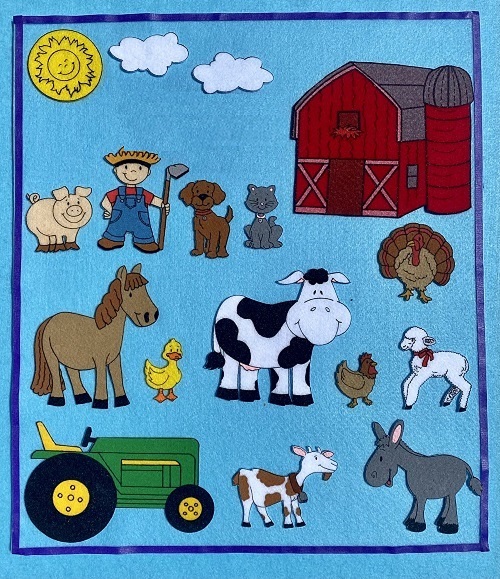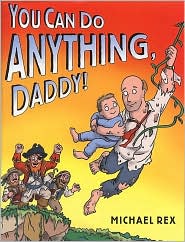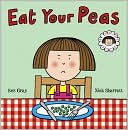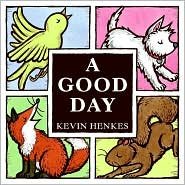Fingerplay: Little Raindrops
This is the sun, high up in the sky. (Form large circle with arms up)
A dark cloud suddenly comes sailing by. (Move hands through the air in a parallel motion.)
These are the raindrops, pitter, pattering down. (Bring arms down, flutter fingers)
Watering the flowers, growing on the ground. (Cup hands to form flowers.)
Activity: Make a book based on this fingerplay. Use the pattern here (Little Raindrops Booklet pattern) to represent the items in the fingerplay. There are four pages for your book (one for each line of the fingerplay). The pattern is a Word document so you can change the size of the objects to save paper, if you wish. The children cut out the pictures. They can cut around them to make it easier. The adults write the words to the fingerplay on each page. For children too young for this craft, the adults make the book FOR their young children. The umbrella can be used on the cover of the book.
Early Literacy Aside--Empower: Making a book with or for your child is very special. By showing care in making them and including your child in the process you make this activity around a book enjoyable. Your child can memorize the words to the rhyme and can "pretend" read it to you. Praise your child. This helps develop print motivation, a child's interest and enjoyment of books and reading. OR Making a book with your child shows them how books work. This helps them with print awareness, how to handle a book, which will get them comfortable with using books as they learn to read. Submitted by Jaime Duval and Whitney Whitaker, Radford (VA) Public Library
 Pass out flannel board pieces of fam animals. Play or sing "Old Macdonald Had a Farm" . When a child hears the animal he/she is holding, that child comes up to place the animal piece on the flannel board.Early Literacy Aside--Example: Having your children hear and make the sounds of the animals is one enjoyable way to help them develop phonological awareness, to eventually be able to hear the smaller sounds in words.
Take-Home Activity: Hand out shapes of animals for families to take home.
Early Literacy Aside--Empower: Parents, you can use these animal shapes to make animal sounds with your children and home and sing the song with them to practice the skill of phonological awareness.
Pass out flannel board pieces of fam animals. Play or sing "Old Macdonald Had a Farm" . When a child hears the animal he/she is holding, that child comes up to place the animal piece on the flannel board.Early Literacy Aside--Example: Having your children hear and make the sounds of the animals is one enjoyable way to help them develop phonological awareness, to eventually be able to hear the smaller sounds in words.
Take-Home Activity: Hand out shapes of animals for families to take home.
Early Literacy Aside--Empower: Parents, you can use these animal shapes to make animal sounds with your children and home and sing the song with them to practice the skill of phonological awareness.

 Book Introduction: Our next story is Mouse Mess by Linnea Riley. Notice the words on boxes and bottles as Mouse finds food to eat.
Read the book, saying the words on the boxes and bottles as you point to them.
Early Literacy Aside--Example: Pointing out the words we see on boxes and bottles is one way to help children develop one of the early literacy skills, print awareness, understanding that print has meaning.
Activity: At the end of storytime put out cereal boxes, bottles, any containers with writing on it and let the children "read" them.
Early Literacy Aside--Empower: Don't forget, when you go shopping or are just out and about, talk with your children about the signs and labels they see, just as we did with Mouse Mess. This is one simple way to develop your children's print awareness.
Book Introduction: Our next story is Mouse Mess by Linnea Riley. Notice the words on boxes and bottles as Mouse finds food to eat.
Read the book, saying the words on the boxes and bottles as you point to them.
Early Literacy Aside--Example: Pointing out the words we see on boxes and bottles is one way to help children develop one of the early literacy skills, print awareness, understanding that print has meaning.
Activity: At the end of storytime put out cereal boxes, bottles, any containers with writing on it and let the children "read" them.
Early Literacy Aside--Empower: Don't forget, when you go shopping or are just out and about, talk with your children about the signs and labels they see, just as we did with Mouse Mess. This is one simple way to develop your children's print awareness. Talk about spiders and how they spin their webs. Each web is different. They use their webs to catch their food.Read the book The Very Busy Spider by Eric Carle.
Put up pieces on a flannel board, having the participants retell the story as you put up the pieces.
Early Literacy Aside--Example: This book has lots of repetition so it is a good one for retelling. I have a handout with the same figures that I used on the flannel board. I will also pass out some yarn to make the web. You can cut out the figures and use the yarn to retell the story. Helping your children to retell stories will help them understand what they read later in school.
Talk about spiders and how they spin their webs. Each web is different. They use their webs to catch their food.Read the book The Very Busy Spider by Eric Carle.
Put up pieces on a flannel board, having the participants retell the story as you put up the pieces.
Early Literacy Aside--Example: This book has lots of repetition so it is a good one for retelling. I have a handout with the same figures that I used on the flannel board. I will also pass out some yarn to make the web. You can cut out the figures and use the yarn to retell the story. Helping your children to retell stories will help them understand what they read later in school. Read the book You Can Do Anything, Daddy by Michael Rex.Craft/Activity: In this book, the boy is thinking of bad things that might happen to him. His father is figuring out how to save his son. I am giving each of you [adults and children] a piece of paper. On one side I want you to draw something you think of that is scary for you. On the other side I want you to think of something your a grownup could do to help you. It is all pretend, make-believe. What can you think of?
Eary Literacy Aside: Having your children draw and then tell you about what they drew develops their narrative skills. It also gives us a window into their thoughts. You can also write down what your children say with the picture so that they make the connection between the written and the spoken word. This helps develop their print awareness, knowing that print has meaning.
Read the book You Can Do Anything, Daddy by Michael Rex.Craft/Activity: In this book, the boy is thinking of bad things that might happen to him. His father is figuring out how to save his son. I am giving each of you [adults and children] a piece of paper. On one side I want you to draw something you think of that is scary for you. On the other side I want you to think of something your a grownup could do to help you. It is all pretend, make-believe. What can you think of?
Eary Literacy Aside: Having your children draw and then tell you about what they drew develops their narrative skills. It also gives us a window into their thoughts. You can also write down what your children say with the picture so that they make the connection between the written and the spoken word. This helps develop their print awareness, knowing that print has meaning.

 As you read the book, ask the children to identify the animals in the book. Talk about the landscape in the pictures--where in the world might this take place? Use words the children may not know (arctic, icebergs, ice floes, glaciers, etc.). Also, talk about Tacky the Penguin's personality, his uniqueness and originality, explaining words children may not know. For an activity, have children and adults draw and color a penguin however they want.Early Literacy Aside--Empower: We used lots of interesting words today with Tacky the Penquin, some were not even in the book. This helps develop your child's vocabulary. On your way home, talk about being creative and ways your child is unique, using some of the interesting words we used today and adding your own. Through talking and talking about your children's drawings there are many opportunities to expand your child's vocabulary.
As you read the book, ask the children to identify the animals in the book. Talk about the landscape in the pictures--where in the world might this take place? Use words the children may not know (arctic, icebergs, ice floes, glaciers, etc.). Also, talk about Tacky the Penguin's personality, his uniqueness and originality, explaining words children may not know. For an activity, have children and adults draw and color a penguin however they want.Early Literacy Aside--Empower: We used lots of interesting words today with Tacky the Penquin, some were not even in the book. This helps develop your child's vocabulary. On your way home, talk about being creative and ways your child is unique, using some of the interesting words we used today and adding your own. Through talking and talking about your children's drawings there are many opportunities to expand your child's vocabulary. Book Introduction: In this book there are four animals (point to them on the cover)--a yellow bird, a white dog, an orange fox, and a brown squirrel. For each animal something sad happens, but then something good does, too! Let's see what happens.Read the book A Good Day by Kevin Henkes.
Sometimes something happens to us that makes us sad, but then we find a way to be happier. I am going to give each person a piece of paper and there are some crayons to share. I would like you to draw a picture of a time you were sad and a time you could make yourself happy. Then tell me or the adult who brought you about your picture.
Early Literacy Aside--Example: Adults, having your child describe their experiences and feelings aloud gives you an opportunity to develop their vocabulary and background knowledge. You can add more words to what they already use and also explain more about the situations they describe.
Book Introduction: In this book there are four animals (point to them on the cover)--a yellow bird, a white dog, an orange fox, and a brown squirrel. For each animal something sad happens, but then something good does, too! Let's see what happens.Read the book A Good Day by Kevin Henkes.
Sometimes something happens to us that makes us sad, but then we find a way to be happier. I am going to give each person a piece of paper and there are some crayons to share. I would like you to draw a picture of a time you were sad and a time you could make yourself happy. Then tell me or the adult who brought you about your picture.
Early Literacy Aside--Example: Adults, having your child describe their experiences and feelings aloud gives you an opportunity to develop their vocabulary and background knowledge. You can add more words to what they already use and also explain more about the situations they describe.
